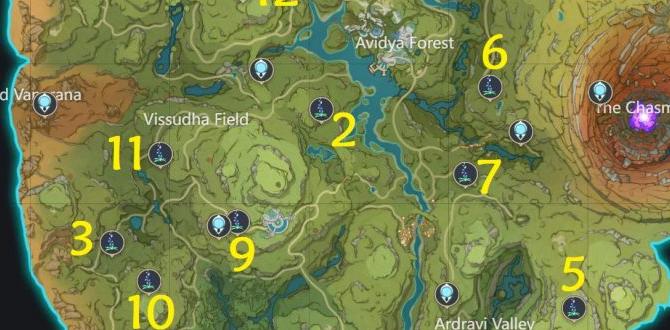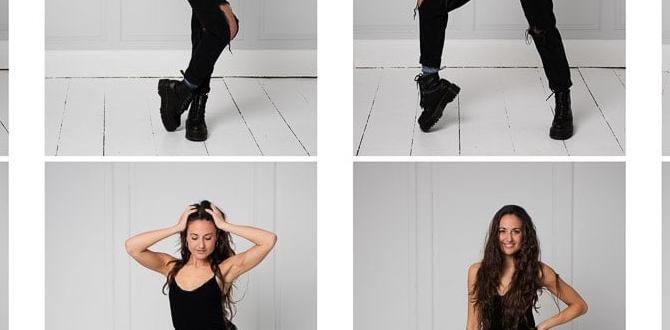Have you ever wondered when is the best time to take pictures outdoors? Imagine capturing a stunning sunset or a bright morning sky. Timing can change everything in photography.
Many people think any time is good for a shot. But the truth is, some times are better than others. For example, have you noticed how soft the light looks during the golden hour? That’s usually just after sunrise and before sunset. Such moments can make your photos look magical.
Fun fact: professional photographers swear by these special times. They create beautiful images that feel warm and inviting. So, if you’re looking to improve your outdoor pictures, understanding the best time to take pictures can help you succeed.
The Best Time To Take Pictures Outdoors For Stunning Shots

Best Time to Take Pictures Outdoors
Choosing the right time makes a big difference in outdoor photography. Early morning and late afternoon provide soft, golden light. This is often called the “magic hour.” Have you ever noticed how stunning sunsets look? Clouds, colors, and shadows add drama to your photos. Additionally, bright sunny days can create harsh shadows. So, consider different times of day for the best results. Your photos will shine brighter with just a little planning!Understanding Natural Light
Types of natural light: golden hour, blue hour, and midday sun. The impact of light direction on photography quality.Natural light can make or break your outdoor photos. There are three main types to know: the golden hour, blue hour, and the dreaded midday sun. The golden hour happens right after sunrise and before sunset, bathing everything in warm, soft light. The blue hour follows, offering a cool, magical glow that’s perfect for evening shoots. Midday sun? Well, it’s bright and harsh, casting shadows that make you feel like you’re playing hide and seek with your subject!
| Light Type | Best for |
|---|---|
| Golden Hour | Soft, warm images |
| Blue Hour | Cool, magical tones |
| Midday Sun | Brilliant but harsh |
Also, remember that the direction of light matters! Light coming from the side creates shadows and depth, while light from above can flatten everything out. So, next time you’re out snapping photos, choose your light wisely to capture the best moments. After all, nobody wants their pictures to look like they were taken during a sunburn marathon!
The Golden Hour Explained
Definition and timing of the golden hour. Ideal conditions for outdoor photography during this time.The golden hour is that magical time just after sunrise or before sunset. During these moments, the sun casts a warm, soft glow. This lighting makes everything look lovely and dreamy. It lasts about an hour, hence the name! Ideal conditions for taking outdoor photos are a clear sky and good weather. So, grab your camera and prepare—nature throws a party of colors during this hour, and everyone wants to join in!
| Time of Day | Duration |
|---|---|
| Sunrise | Approximately 1 hour |
| Sunset | Approximately 1 hour |
The Blue Hour Benefits
Definition and timing of the blue hour. How blue hour can enhance landscape and cityscape photography.The blue hour happens just before sunrise and just after sunset. During this magical time, the sky turns a deep blue. This special light can make your pictures shine. It adds softness to landscapes and buildings. You’ll capture colors that pop and details that stand out.
- Perfect for stunning landscapes.
- Enhances cityscapes with glowing lights.
- Great for creating a peaceful mood.
What makes the blue hour special for photography?
The blue hour offers unique lighting that adds depth and beauty to images, making it the best time for stunning outdoor photography.
Mid-Day Photography Challenges
Harsh lighting and shadows effects. Best practices for shooting during midday.Taking photos at midday can feel like a challenge. The sun is high, which means harsh lighting. This can create deep shadows and can make pictures look less appealing. Think of it as nature’s way of testing your skills! To tackle this, it’s best to find shady spots or use a diffuser to soften the light. You can also try adjusting your angle to reduce those pesky shadows. Remember, even on tough days, a little creativity can turn a sunny disaster into a beautiful masterpiece!
| Tips for Midday Photography | Best Practices |
|---|---|
| Stay in the shade | It helps reduce harsh shadows. |
| Use diffusers | Softens the direct sunlight. |
| Change your angle | Minimizes shadow effects. |
Seasonal Considerations for Outdoor Photography
How seasons influence light quality and colors. Seasonal best times for capturing specific landscapes.Seasons can turn a simple photo into a masterpiece! Each season brings its own special light and colors. For example, spring dazzles with vibrant blooms, while fall offers stunning golden leaves. Summer can bathe landscapes in bright, sunny hues, and winter adds a stark, frosty beauty. Check out the table below for the best times to capture specific scenes:
| Season | Best for |
|---|---|
| Spring | Flowers & Greenery |
| Summer | Beaches & Sunsets |
| Fall | Colorful Leaves |
| Winter | Snowy Landscapes |
Next time you grab your camera, think about the season. It can change the mood of your photos like snacks change a boring lunch. Happy shooting!
Strategic Location Choices
Identifying locations that enhance natural light benefits. How background and foreground interaction changes at different times.Finding the right spot is key for awesome outdoor photos. Locations with open skies let more light shine in. Look for places with many colors, like gardens or parks. This helps the colors pop in your pictures. Notice how the background and foreground change at different times of day. For example, morning sunlight is soft, while afternoon light can be harsh. Here are some tips:
- Choose bright areas for clear shots.
- Check shadows that might block light.
- Scout spots early in the day.
- Use natural frames like trees or archways.
What is the best time to take pictures outdoors?
The best time to take pictures outdoors is during the golden hour which is just after sunrise or just before sunset. During this time, the light is warm and soft, creating beautiful effects in photos.
Weather Conditions and Their Impact
How different weather conditions affect outdoor photography. Optimal weather scenarios for capturing stunning images.Weather affects outdoor photography in big ways. Sunny days can create bright colors. Overcast skies provide soft light, making for even pictures. Wind can move trees and flowers, adding life to shots. Rain can make everything look fresh and vibrant. For the best photos, aim for:
- Sunrise or sunset for beautiful colors.
- Clear skies for bright images.
- Cloudy days for softer shadows.
These weather conditions make each photo special. Choose wisely to capture stunning outdoor images!
What is the best weather for taking pictures outdoors?
The best weather for outdoor photography is clear skies or softly overcast days. These conditions help bring out colors and details in your photos. Remember to check local forecasts before heading out!
Tips for Planning Outdoor Photography Sessions
Tools and apps to track sunrise/sunset times. Preparing for location scouting and time management.Getting ready for outdoor photography? First, grab some handy tools and apps to track those magical sunrise and sunset times. Believe me, those golden hours are pure gold for a photographer! You don’t want the sun to hide behind a mountain while you’re still setting up your shot.
Make a plan for your location scouting. Not all spots are equal, and some have better lighting than others. Don’t forget to manage your time wisely! Set reminders, so you aren’t running to catch the light like a startled squirrel!
| Tool/App | Features |
|---|---|
| Sun Seeker | Tracks sun position and shows sunrise/sunset times |
| PhotoPills | Calculates sun and moon positions for perfect shots |
Post-Processing for Different Times of Day
Techniques for enhancing photos taken during different times. Adjustments to consider based on lighting conditions.Different times of day offer unique lighting challenges and opportunities for your outdoor photos. Morning light is soft and warm, perfect for capturing vibrant colors. Midday sun, however, can be harsh and create unflattering shadows. You might want to use **backlighting** to add sparkle to your shots. As the sun sets, the golden hour casts a magical glow. Enhance your images by adjusting brightness and contrast. Here’s a quick guide:
| Time of Day | Techniques |
|---|---|
| Morning | Use warm filters |
| Midday | Lower exposure |
| Evening | Play with colors |
With these adjustments, your pictures will shine brighter than a kid on a sunny day! Remember, a little tweak can turn a good photo into a great one!
Conclusion
In summary, the best time to take pictures outdoors is during golden hour, just after sunrise or before sunset. This time gives warm, soft light. Avoid harsh midday sun for better results. We can also explore different seasons for unique backgrounds. So grab your camera, head outside, and start shooting! For more tips, check out photography guides or online resources.FAQs
What Are The Advantages Of Taking Outdoor Photos During The Golden Hour?Taking photos during the golden hour makes everything look magical. The sunlight is soft and warm, giving your pictures a nice glow. Shadows are gentle, so you can see more details. Colors become brighter and richer, like in a beautiful painting. This special time helps you capture amazing memories!
How Do Weather Conditions Impact The Quality Of Outdoor Photography?Weather affects outdoor photography in many ways. Bright sunlight can create strong shadows, making some pictures too bright. On cloudy days, the light is softer and can make colors look richer. Rain can create puddles that add interesting reflections, but it can also make your camera wet. So, different weather can change your photos a lot!
What Time Of Day Provides The Best Natural Lighting For Outdoor Portraits?The best time for outdoor portraits is during the golden hour. This happens just after sunrise and just before sunset. The light during these times is soft and warm. It makes everyone look great! So, try to take photos early in the morning or late in the evening.
Are There Specific Seasons That Are Better For Taking Outdoor Landscape Photographs?Yes, some seasons are better for outdoor landscape photos. Spring shows beautiful flowers and green trees. Summer has bright sunlight and clear skies. Fall makes everything look colorful with red and yellow leaves. Winter can create stunning snowy scenes. Each season has its special charm for pictures!
How Can I Plan My Outdoor Photo Shoots Around The Sun’S Position And Shadow Patterns?To plan your outdoor photo shoots, look at the sun’s position. The sun moves across the sky from east to west. You can use apps or websites to see where the sun will be during your shoot. Try to take pictures in the early morning or late afternoon. This way, the sunlight is softer, and shadows look better.
{“@context”:”https://schema.org”,”@type”: “FAQPage”,”mainEntity”:[{“@type”: “Question”,”name”: “What Are The Advantages Of Taking Outdoor Photos During The Golden Hour? “,”acceptedAnswer”: {“@type”: “Answer”,”text”: “Taking photos during the golden hour makes everything look magical. The sunlight is soft and warm, giving your pictures a nice glow. Shadows are gentle, so you can see more details. Colors become brighter and richer, like in a beautiful painting. This special time helps you capture amazing memories!”}},{“@type”: “Question”,”name”: “How Do Weather Conditions Impact The Quality Of Outdoor Photography? “,”acceptedAnswer”: {“@type”: “Answer”,”text”: “Weather affects outdoor photography in many ways. Bright sunlight can create strong shadows, making some pictures too bright. On cloudy days, the light is softer and can make colors look richer. Rain can create puddles that add interesting reflections, but it can also make your camera wet. So, different weather can change your photos a lot!”}},{“@type”: “Question”,”name”: “What Time Of Day Provides The Best Natural Lighting For Outdoor Portraits? “,”acceptedAnswer”: {“@type”: “Answer”,”text”: “The best time for outdoor portraits is during the golden hour. This happens just after sunrise and just before sunset. The light during these times is soft and warm. It makes everyone look great! So, try to take photos early in the morning or late in the evening.”}},{“@type”: “Question”,”name”: “Are There Specific Seasons That Are Better For Taking Outdoor Landscape Photographs? “,”acceptedAnswer”: {“@type”: “Answer”,”text”: “Yes, some seasons are better for outdoor landscape photos. Spring shows beautiful flowers and green trees. Summer has bright sunlight and clear skies. Fall makes everything look colorful with red and yellow leaves. Winter can create stunning snowy scenes. Each season has its special charm for pictures!”}},{“@type”: “Question”,”name”: “How Can I Plan My Outdoor Photo Shoots Around The Sun’S Position And Shadow Patterns? “,”acceptedAnswer”: {“@type”: “Answer”,”text”: “To plan your outdoor photo shoots, look at the sun’s position. The sun moves across the sky from east to west. You can use apps or websites to see where the sun will be during your shoot. Try to take pictures in the early morning or late afternoon. This way, the sunlight is softer, and shadows look better.”}}]}




